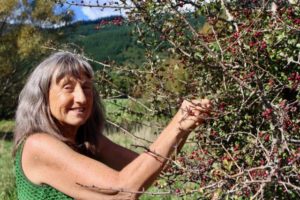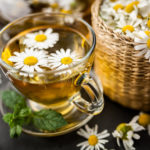I’ve recently enjoyed a visit to the Nelson area in the South Island where my friend Jasmin and I went searching for Hawthorn shrubs Craetagus monogyna . Its autumn and time to harvest the small red fruits (called haws). We found some bushes along roadside farm fences abundant with haws. Hawthorn is native to Europe and was brought here as an effective and attractive hedge plant. It’s Greek name Craetagus means flowering thorn and I was certainly made aware of the stiff 12mm long spines that are there to protect the nourishing and medicinal spring flowers, leaves and autumn fruits.

Hawthorn flowers, leaves and fruit from Plants for a Future website.
Hawthorns are densely branched, thorny deciduous shrubs in the Rose family that can reach up to 10 m tall. During Oct-Nov in NZ (or May in England where it is called ‘May’) they are covered in white or pink flowers that smell both pleasant and a bit sickly. There is a custom of going ‘a-Maying’ – cutting flowering branches to cover doorways and choosing a May queen as part of a maypole fertility ritual that goes back to pagan times, when it was thought the blossom was a blessing from the goddess of fertility who watched over forest and field. In rural Ireland and England farmers still wait for ‘May’ to flower before ploughing the fields or shearing the sheep. But ‘May’ has a darker side being forbidden to carry indoors as it could bring illness or even death.
I love these cultural and historical stories that reveal how intertwined plants are in our lives and cultures. As such Hawthorn has been revered by traditional herbalists as well as being one of the most scientifically studied medicinal herbs. It shows impressive anti-inflammatory effect in the blood vessels and protection of the heart while enhancing its function. And the best part is its safety. It can be used confidently alongside conventional medicine. Its action is to open circulation, decrease blood pressure and steady the heartbeat. Further it calms the autonomic nervous system and improves sleep. I can vouch for it helping me sleep!
The parts to use are the flowers and young spring leaves – heart shaped and finely toothed or deeply lobed like oak leaves. You can add these to salads or smoothies. Gather enough flowers and leaves to dry for long term use. All parts are rich in flavonoids ( cell signalling pathway benefits and antioxidant
effects). Since I’ve just harvested the haws resembling mini apples, I’m making infusions by boiling them with some slices of ginger. Being safe, food-like and very effective when used regularly, the red fruits act as a tonic (enhancing physiological functioning rather than treating disease).
It is hard to understand why Hawthorn is not used more in the health care system. One author suggests we don’t use medicine that hasn’t been tinkered with, nor trust already complete medicine hanging on a weedy, scraggly, thorny bush standing in a waste place. It seems we’ve become afraid of what is unknown, unhybridized and uncontrolled. My aim is to raise awareness about Hawthorn for daily prevention of disease and for enhancing our health.
Hawthorn Blossom Tea
A few tablespoons of leaf and flower
Linden blossom (optional)
1 cup hot water
A litre per day can reduce high blood pressure when taken consistently over months.
Hawthorn Berry Tea
A handful of haws including some stalks
3 or 4 thin slices of ginger (optional)
4 cups water
Pour the water over the haws and bring to the boil. Simmer for twenty minutes, strain and add honey to taste. You can reuse the berries for a second brew.
Hawthorn Jam
Fresh or rehydrated hawthorn berries
Vegetable mill
Put the berries in a pot and barely cover with water. Cook over low heat, stirring and mashing them with a fork. After an hour you’ll have a rich, reddish-orange mass with hard seeds all through it. Pass the pulp through a vegetable mill (the old kind with a hand cranked handle that goes around in circles). This separates out the seeds which you discard. You can either bottle this hot liquid or fill jars and freeze the jam.
Take two tablespoons of this medicine daily off a spoon, spread on toast or on your porridge. A delicious way to take your medicine!







Love this article thank you. I remember the hawthorn trees in the uk beautiful specimens. Do you think they would grow well in Gisborne? Given our mild winters am not sure if they require a good cold wintry frost.
Hi Julia, thanks so much for your feedback – awesome you wrote. I reckon there is no harm in trying to grow hawthorn over in Gisborne since it is fairly mild here in Tauranga too. I picked those big ones in McLaren Falls park and the wild ones were down in the Nelson area which is also fairly warm. I think Hawthorn might like it. I am so enjoying getting to know it and use it. Warm wishes, Julia
Hi Julia
I’m keen to try and grow it here in Gisborne too, and possibly elderberry. Keep in touch if you like and let me know how you get on
Thank you Julia for replying I will give Hawthorn a go!
Hi Tania
I have some elderflower cuttings that are growing well if you want one?
Great Julia that you are giving Hawthorn a go.
Elderflower is great to grow. Do you use it Julia – flowers and berries? I’m going to write about it in the spring when if flowers. Best wishes Julia
I intend to use it when its grown a bit it’s just a tiny plant at the mo. They are beautiful trees!
Hi Julia,
Your information on the Hawthorn reminded me of when I was young growing up in the Cornish countryside in the UK. I picked some of the Hawthorn flowers as i thought they were very pretty and took them back home to give to my Mother. My Mother quickly took them off me & threw them outside. As you can imagine I was very upset as I didn’t understand why she would do that. She then told me of the folklaw & how unlucky it was to bring into a house. I never picked it again but enjoyed the blossoms on the trees.
Liz
HI Liz, that is really interesting and shows how strongly ingrained these folk lore beliefs can be. They are lovely on the bushes never the less. I’ve sent you a link to Kahikatea farm in the Wairarapa who has them for sale. I hope it grows well for you.